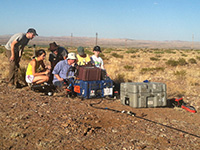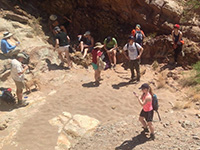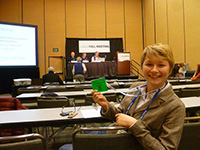Fourteen IRIS undergraduate interns completed their research last summer under the guidance of seismologists from across the United States. This was the 19th year of the Summer Internship Program and over that time a total of 182 students have conducted research at over 50 different IRIS member and affiliate institutions.

IRIS interns begin their 9-11 weeks of summer research by taking part in an intensive week-long orientation held at New Mexico Institute of Mining and Technology and the IRIS PASSCAL Instrument Center, to develop a sense of community among the students and provide an introduction to some aspects of modern seismology. The interns then travel to IRIS-related institutions throughout the US, and sometimes the world, to work with seismologists in both lab-based and field-based settings where they develop research products worthy of presentation at large professional conferences. The research topics expose students to many of the broader aspects of the geosciences and include the full spectrum of specialties within seismology, ranging from imaging the structure of Earth's inner-outer core boundary with implications for models of the geodynamo, to mapping shallow faults that present a significant hazard to population centers.
To capitalize on IRIS’s resources and mentoring pool, the Research Experiences for Undergraduates program employs a distributed approach that helps bond students into a group despite conducting their research at geographically distributed sites. In addition to the orientation described above, this approach includes a cyberinfrastructure to encourage group interaction and enable peer-learning and collaboration. The students then have the opportunity to reconnect face-to-face and become integrated into the intern alumni network at the annual Fall Meeting of the American Geophysical Union that is attended by over 24,000 geophysicists from around the world. An alumni mentor also provides experienced, consistent support throughout the summer, giving independent guidance relating to the intern experience. An important benefit of the longevity of IRIS’s Internship Program is the depth of the alumni community it has created and the resulting exchange of experiences between participants from different years. For example, it is not uncommon for interns to find program alumni working in the lab where they will be spending their summer, which provides many informal mentoring opportunities.
Indicative of the success of this program, a survey of over 110 program alumni from 1998-2013 found that 89% of the respondents who had completed their undergraduate degrees were pursuing advanced degrees in the geosciences or are working in a geoscience field. Alumni of the Internship Program are employed as research or teaching faculty and as staff geophysicists or geologists at petroleum companies, environmental engineering firms, and at the US Geological Survey. In fact, the program has come full circle — program alumni that are part of the IRIS community are now hosting interns for the summer!
 During the summer intern orientation, IRIS research interns learn how to connect portable seismic sensors. During the summer intern orientation, IRIS research interns learn how to connect portable seismic sensors. |
 Interns take a break during the orientation program's geology field trip. Interns take a break during the orientation program's geology field trip. |
 An intern attends the American Geophysical Union’s Fall Meeting. An intern attends the American Geophysical Union’s Fall Meeting. |